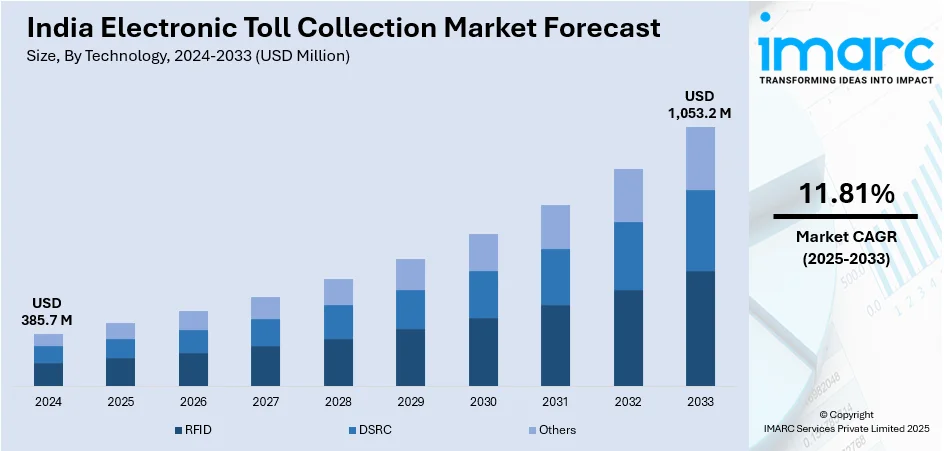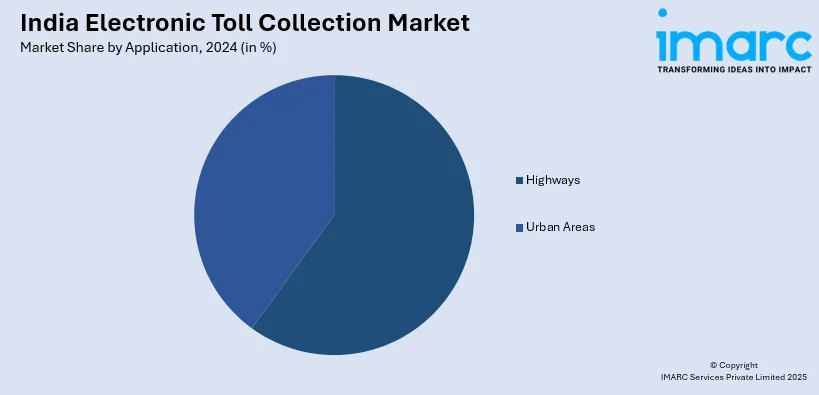
India Electronic Toll Collection Market Size, Share, Trends and Forecast by Technology, System, Sub System, Offering, Toll Charging, Application, and Region, 2025-2033
Market Overview:
India electronic toll collection market size reached USD 385.7 Million in 2024. Looking forward, IMARC Group expects the market to reach USD 1,053.2 Million by 2033, exhibiting a growth rate (CAGR) of 11.81% during 2025-2033. The increasing demand for automated toll collection systems that reduce the operational costs associated with manual toll collection, such as labor, maintenance, and printing of paper ticket, is driving the market.
|
Report Attribute
|
Key Statistics
|
|---|---|
|
Base Year
|
2024 |
|
Forecast Years
|
2025-2033
|
|
Historical Years
|
2019-2024
|
| Market Size in 2024 | USD 385.7 Million |
| Market Forecast in 2033 | USD 1,053.2 Million |
| Market Growth Rate (2025-2033) | 11.81% |
Electronic toll collection (ETC) is a streamlined and automated system for collecting tolls on highways and bridges. It replaces traditional toll booths with technology that allows vehicles to pass through toll points seamlessly, eliminating the need for stopping and manual payment. ETC employs radio frequency identification (RFID) or other wireless communication technologies to identify vehicles and deduct toll charges electronically. As a vehicle equipped with an ETC transponder approaches a toll booth, the system automatically deducts the toll amount from the user's prepaid account or charges it through a linked payment method. This not only reduces traffic congestion and travel time but also enhances overall toll collection efficiency. ETC systems are widely adopted in various regions as they offer a convenient, cashless, and time-saving solution for both authorities and commuters.

To get more information on this market, Request Sample
India Electronic Toll Collection Market Trends:
The electronic toll collection market in India is experiencing robust growth, primarily propelled by the increasing demand for seamless and efficient transportation systems. To begin with, the surge in urbanization and population density has led to heightened traffic congestion, necessitating advanced toll collection mechanisms. Furthermore, the escalating need for reducing travel time and enhancing overall traffic management has accentuated the adoption of electronic toll collection systems. In addition, government initiatives to modernize transportation infrastructure have significantly contributed to the expansion of the ETC market. Moreover, the regional emphasis on environmental sustainability has driven the adoption of ETC as a means to reduce fuel consumption and emissions by minimizing vehicle idling time at toll booths. The growing trend towards digitalization and the increasing penetration of connected vehicles have further amplified the demand for electronic toll collection. As a result, the integration of ETC with emerging technologies such as the Internet of Things (IoT) and artificial intelligence has become a key driver, promising enhanced operational efficiency and real-time monitoring capabilities. In conclusion, the electronic toll collection market in India is propelled by a confluence of factors, ranging from urbanization and government initiatives to environmental concerns and technological advancements.
India Electronic Toll Collection Market Segmentation:
IMARC Group provides an analysis of the key trends in each segment of the market, along with forecasts at the country level for 2025-2033. Our report has categorized the market based on technology, system, sub system, offering, toll charging, and application.
Technology Insights:
- RFID
- DSRC
- Others
The report has provided a detailed breakup and analysis of the market based on the technology. This includes RFID, DSRC, and others.
System Insights:
- Transponder - or Tag-Based Toll Collection Systems
- Other Toll Collection Systems
A detailed breakup and analysis of the market based on system have also been provided in the report. This includes transponder - or tag-based toll collection systems and other toll collection systems.
Sub System Insights:
- Automated Vehicle Identification
- Automated Vehicle Classification
- Violation Enforcement System
- Transaction Processing
The report has provided a detailed breakup and analysis of the market based on the sub system. This includes automated vehicle identification, automated vehicle classification, violation enforcement system, and transaction processing.
Offering Insights:
- Hardware
- Back Office and Other Services
A detailed breakup and analysis of the market based on offering have also been provided in the report. This includes hardware and back office and other services.
Toll Charging Insights:
- Distance Based
- Point Based
- Time Based
- Perimeter Based
The report has provided a detailed breakup and analysis of the market based on the toll charging. This includes distance based, point based, time based, and perimeter based.
Application Insights:

- Highways
- Urban Areas
A detailed breakup and analysis of the market based on application have also been provided in the report. This includes highways and urban areas.
Regional Insights:
- North India
- West and Central India
- South India
- East and Northeast India
The report has also provided a comprehensive analysis of all the major regional markets, which include North India, West and Central India, South India, and East and Northeast India.
Competitive Landscape:
The market research report has also provided a comprehensive analysis of the competitive landscape in the market. Competitive analysis such as market structure, key player positioning, top winning strategies, competitive dashboard, and company evaluation quadrant has been covered in the report. Also, detailed profiles of all major companies have been provide
India Electronic Toll Collection Market Report Coverage:
| Report Features | Details |
|---|---|
| Base Year of the Analysis | 2024 |
| Historical Period | 2019-2024 |
| Forecast Period | 2025-2033 |
| Units | Million USD |
| Scope of the Report | Exploration of Historical Trends and Market Outlook, Industry Catalysts and Challenges, Segment-Wise Historical and Future Market Assessment:
|
| Technologies Covered | RFID, DSRC, Others |
| Systems Covered | Transponder - or Tag-Based Toll Collection Systems, Other Toll Collection Systems |
| Sub Systems Covered | Automated Vehicle Identification, Automated Vehicle Classification, Violation Enforcement System, Transaction Processing |
| Offerings Covered | Hardware, Back Office and Other Services |
| Toll Chargings Covered | Distance Based, Point Based, Time Based, Perimeter Based |
| Applications Covered | Highways, Urban Areas |
| Regions Covered | North India, West and Central India, South India, East and Northeast India |
| Customization Scope | 10% Free Customization |
| Post-Sale Analyst Support | 10-12 Weeks |
| Delivery Format | PDF and Excel through Email (We can also provide the editable version of the report in PPT/Word format on special request) |
Key Benefits for Stakeholders:
- IMARC’s industry report offers a comprehensive quantitative analysis of various market segments, historical and current market trends, market forecasts, and dynamics of the India electronic toll collection market from 2019-2033.
- The research report provides the latest information on the market drivers, challenges, and opportunities in the India electronic toll collection market.
- Porter's five forces analysis assist stakeholders in assessing the impact of new entrants, competitive rivalry, supplier power, buyer power, and the threat of substitution. It helps stakeholders to analyze the level of competition within the India electronic toll collection industry and its attractiveness.
- Competitive landscape allows stakeholders to understand their competitive environment and provides an insight into the current positions of key players in the market.
Key Questions Answered in This Report
The electronic toll collection market in India was valued at USD 385.7 Million in 2024.
The India electronic toll collection market is projected to exhibit a (CAGR) of 11.81% during 2025-2033, reaching a value of USD 1,053.2 Million by 2033.
The market is fueled by increasing traffic congestion, digital infrastructure development, and government policies such as FASTag. The demand for effective toll collection, decreased vehicle idling time, and enhanced fuel efficiency favors adoption. Furthermore, increased vehicle ownership and desire for hassle-free travel experiences are pushing the country toward automated tolling solutions.
Need more help?
- Speak to our experienced analysts for insights on the current market scenarios.
- Include additional segments and countries to customize the report as per your requirement.
- Gain an unparalleled competitive advantage in your domain by understanding how to utilize the report and positively impacting your operations and revenue.
- For further assistance, please connect with our analysts.
 Request Customization
Request Customization
 Speak to an Analyst
Speak to an Analyst
 Request Brochure
Request Brochure
 Inquire Before Buying
Inquire Before Buying




.webp)




.webp)












